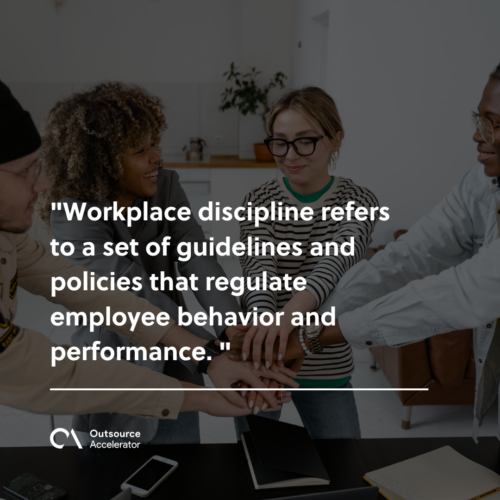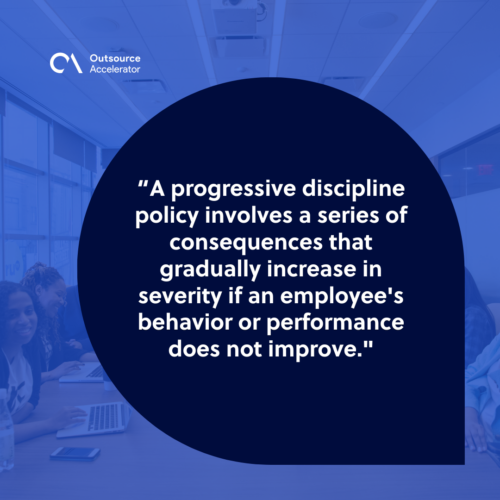How workplace discipline benefits the company

Navigating the complexities of the modern workplace requires more than just talent and dedication. It demands a structured approach to ensure everyone is on the same page.
Workplace discipline, often misunderstood as a rigid set of rules, is, in fact, the linchpin of organizational success. It is especially important to focus on this as more companies provide flexible work opportunities.
A Paychex survey found that since COVID-19, 48% of workers indicated having reported an issue to their HR departments.
That statistic reveals that workplace concerns are on the rise. Naturally, one of the remedies is enforcing effective and appropriate disciplinary measures.
Read on to learn about workplace discipline and effective strategies for its implementation.
What is workplace discipline?
Workplace discipline refers to a set of guidelines and policies that regulate employee behavior and performance. It encompasses both the expectations and consequences of actions taken within the workplace.
This discipline ensures employees adhere to company policies, maintain professionalism, and contribute to a harmonious work environment.

Importance of workplace discipline
There are plenty of reasons why organizations must install workplace discipline:
Maintains order and productivity
Workplace discipline establishes clear boundaries and expectations, which helps maintain order and professionalism.
When employees know what is expected of them and the consequences of non-compliance, they are likelier to stay focused and deliver their best work.
Improves employee performance
Discipline in the workplace encourages employees to take ownership of their responsibilities.
Employees understand how their actions impact the company’s overall success by setting performance standards and providing constructive feedback. This leads to improved productivity and higher-quality work.
Fosters a positive work environment
A disciplined workplace promotes a positive and respectful culture. When employees hold themselves accountable for their actions, they create an atmosphere of trust and collaboration.
This, in turn, boosts employee morale and reduces conflicts, leading to a healthier work environment. ZipDo reports that a positive work culture makes employees 12% more productive.
Enhances company reputation
A company known for its disciplined work environment gains a positive reputation in the industry.
Clients and customers are likelier to trust and choose a company where employees demonstrate professionalism and policy adherence. This can lead to long-term success and more business opportunities.
How to implement workplace discipline
Implementing effective workplace discipline requires a thoughtful and proactive approach. Here are some strategies to consider:
Use a progressive discipline policy
Progressive discipline is among the most common approaches in addressing workplace misconduct or performance issues.
It involves a series of consequences that gradually increase in severity if an employee’s behavior or performance does not improve.

Here’s how to incorporate progressive discipline into your workplace discipline strategy:
1. Verbal warning
Begin with a private conversation with the employee to discuss their behavior or performance concerns.
Communicate the issues, expectations, and consequences clearly if the situation persists. Document the conversation for reference.
2. Written warning
If the employee’s behavior or performance does not improve, issue a written warning. Clearly outline the:
- Specific concerns
- Expected changes
- Timeframe for improvement
Ensure the employee signs the document to acknowledge receipt and understanding.
3. Suspension or probation
If the employee fails to improve after a written warning, consider implementing a suspension or probation period.
During this time, the employee may be suspended without pay or placed on a structured performance improvement plan.
Clearly relay the terms and conditions and provide regular check-ins or evaluations.
4. Termination
Termination may be necessary if the employee does not meet the required standards even after the previous steps.
Prioritize fairness and legality throughout the process, ensuring compliance with labor laws and company policies. Document the reasons for termination and ensure proper communication with the employee.
Strategies for workplace discipline implementation
Effective workplace discipline requires consistent implementation, documentation, and adherence to policies. Here are some tips to consider when enforcing it:
Clearly communicate expectations
Ensure employees know the company’s policies, rules, and performance expectations from the start.
Provide a handbook or documentation outlining these requirements. These could cover attendance, punctuality, dress code, and ethical conduct.
Regularly communicate any updates or changes to these policies to maintain transparency.
Consistently enforce policies and consequences
Consistency is key when it comes to workplace discipline. Ensure that policies are enforced uniformly across all employees and departments.
Otherwise, favoritism or a lack of fairness may breed resentment and negatively impact morale.
It is also crucial to consistently apply consequences for policy violations. This reinforces the importance of adhering to the established guidelines.
Provide training and support
Staff should receive training and guidance to understand the company’s policies and expectations.
Training programs could take the form of seminars, workshops, or online courses covering topics such as:
- Communication
- Conflict resolution
- Ethical behavior
Lead by example
Leaders and managers are pivotal in setting the tone for workplace discipline. They must demonstrate exemplary behavior, consistently following company policies themselves.
Leading by example inspires employees to uphold the same level of discipline and professionalism in their own work.
Workplace discipline: Dos and don’ts
To ensure workplace discipline is effectively enforced, here are some do’s and don’ts to keep in mind:
Dos
- Be proactive. Proactively identify and tackle potential issues before they escalate into major concerns.
- Encourage open communication. Create a culture where employees feel comfortable discussing concerns.
- Recognize and reward positive behavior. Acknowledge and incentivize employees who consistently adhere to discipline standards.
- Promote team collaboration. Foster an environment where employees collaborate and support one another.
- Be fair. Ensure that disciplinary actions are impartial and just.
- Document everything. Maintain thorough records of disciplinary actions and discussions.
- Talk to supervisors. Keep communication lines open with supervisors to address concerns promptly.
- Regularly check in with employees. Always assess the well-being and job satisfaction of your team.

Don’ts
- Micromanage. Trust your employees to fulfill their responsibilities without excessive supervision.
- Ignore issues. Address problems promptly to prevent them from becoming larger challenges.
- Apply one-size-fits-all solutions. Recognize individual differences and tailor disciplinary approaches accordingly.
- Punish without explanation. Communicate the reasons behind disciplinary actions to foster understanding.
- Overlook employee feedback. Actively seek and consider employee input when refining discipline policies.
- Threaten employees. Avoid using threats or intimidation tactics when addressing disciplinary matters.
- Make discipline personal. Separate the behavior from the person. Avoid taking disciplinary actions about personal opinions or biases.
The power of workplace discipline
Workplace discipline is an essential component of any successful company. With it, you can create a positive work environment that fosters productivity, professionalism, and long-term success.
Implementing effective discipline in the workplace not only benefits the company as a whole but also empowers employees to grow and excel in their roles.
Remember, it’s an ongoing effort that requires commitment and consistency, but the rewards are well worth the investment.







 Independent
Independent




